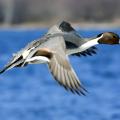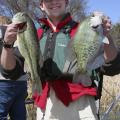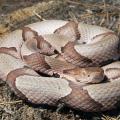Extension Outdoors from 2014
MISSISSIPPI STATE -- Small in size but large in visual appeal, hummingbirds are one of the most popular birds around for watching and feeding.
Hummingbirds get their name because of the humming sound created by their wings, which beat at high frequencies audible to humans. They hover in mid-air with rapid wing beats, typically around 50 times per second. Their wing beats can be as high as 200 times per second, allowing them to fly at speeds exceeding 30 mph, even backwards or upside down.
Mississippi summers evoke thoughts of family vacations, rainy days and outdoor explorations. But with the heat and humidity come tiny critters that, if not discovered quickly, can ruin a fun day.
Nineteen species of ticks exist in Mississippi, but only a few are known to bite humans.
By James E. “Jim” Miller
Professor Emeritus, Department of Wildlife Fisheries and Aquaculture
MSU Extension Service
MISSISSIPPI STATE -- That first raucous, exhilarating gobble of the spring season heralds the thrill of the chase for millions of North American turkey hunters, including me.
Historians estimate between 7 and 10 million wild turkeys roamed the continent prior to European settlement. However, by the 1930s, only 30,000 birds remained, most in isolated populations in a few states.
MISSISSIPPI STATE -- Largemouth bass are one of the most popular sport fish in Mississippi, and many anglers chase these beasts on the Magnolia State’s medium to large reservoirs every day.
With a little help from the pond owner, though, smaller bodies of water -- one acre and larger -- can also produce trophy bass consistently.
MISSISSIPPI STATE -- Every July, waterfowl biologists from the Mississippi Flyway Council, comprised of 14 states and 3 Canadian provinces, look at many factors to predict the total number of ducks available for harvest in the fall flight forecast. Then they use this number to determine the framework of seasons, dates and bag limits for the fall hunting season.
This year we are expected to have an annual fall flight of 49.2 million birds, which is an 8 percent growth in population from last year and 43 percent higher than the long-term average for North American waterfowl.
As fall approaches, many hunters and landowners begin to turn their attention toward planting cool-season wildlife food plots. If you’re like me, it’s something you enjoy doing, and it’s a good excuse to get outside and play in the dirt.
But while you’re out there having fun, you might as well get the most for your time and money. Here are some often overlooked, but important, tips and suggestions for making the most of your cool-season food plots this fall and winter.
By James E. “Jim” Miller
Professor Emeritus, Department of Wildlife Fisheries and Aquaculture
MSU Extension Service
MISSISSIPPI STATE -- The American beaver, the largest native rodent in North America, is an ecosystem engineer, building dams and creating ponds that contribute to plant and animal biodiversity. However, beavers can cause serious property damage and frustrate landowners and managers.
MISSISSIPPI STATE -- Many landowners would like to fish for crappie in their ponds and small lakes, but crappie can cause major problems in smaller waters.
The diet of crappie is very similar to the diet of other desired pond species, such as bass and bream. This overlap in dietary needs between species is not a problem when the population of crappie in a pond is low.
By James E. “Jim” Miller
Professor Emeritus, Department of Wildlife Fisheries and Aquaculture
Mississippi State University
People discard millions of tons of trash daily in recycling containers or garbage cans, but unfortunately, many people leave trash in other places, where it can harm wildlife and pets.
Whether it is carelessly tossed out of car windows or off the sides of boats, left on the ground from routine farming or construction activities, or casually dropped while walking down the street, litter is more than an unsightly nuisance.
MISSISSIPPI STATE -- Whether you are a small-scale gardener, a large agricultural producer or somewhere in between, you probably know that soil health is just as important to your success as water and sunshine.
Ray Iglay, Certified Wildlife Biologist
MSU Department of Wildlife Fisheries and Aquaculture
MISSISSIPPI STATE -- Driving along Mississippi highways is always best when the surrounding landscapes capture the driver’s imagination. Our road systems serve as scenic byways showcasing nature’s beauty.
“The only good snake is a dead snake” is an attitude probably triggered by common myths about snakes.
Snake myths are found in cultures around the globe, giving evidence of the troubled relationship between people and these reptiles. People are often afraid when they do not need to be. There are more snake myths than one article can cover, but let’s expose a few of the more common ones to the truth.
Myth: Rattlesnakes always give a warning rattle before they strike.
MISSISSIPPI STATE -- Most people think of pond fishing and management as a warm weather affair, but there is much to do -- and catch -- during the cooler months of the year.
Winter drawdown can be a useful tool for the farm pond manager, if done properly. It poses no threat to the fish population and costs nothing if the pond is equipped with a water control structure. Water level drawdown prevents or corrects overcrowding of prey fish and reduces nuisance weeds in ponds.
MISSISSIPPI STATE -- The sight of a flickering camp fire. The glow of faces bathed in warm firelight. The sound of crickets chirping in the background.
Research shows connecting with nature and one another is helpful to hurried and task-weary souls. Camping is one way to relax, get outdoors and reconnect with loved ones. If you have never experienced the rewards of camping, fall is the perfect time to try it.
MISSISSIPPI STATE -- Bats are popular, but often misunderstood, Halloween symbols. These strange-looking mammals generate fear among children and adults alike, but the truth about bats is really quite fascinating.
With more than 1,200 species worldwide, bats are divided into two suborders -- Microbats and Megabats. All bats have webbed wings, making them the only mammal capable of true flight. Bats are present throughout the world, with the exception of Antarctica and the northernmost parts of North America, Europe and Asia.
By James E. “Jim” Miller
Professor Emeritus, Department of Wildlife Fisheries and Aquaculture
MSU Extension Service
MISSISSIPPI STATE -- Hunting is about individual responsibility. Aldo Leopold, the father of wildlife management, said, “A particular virtue in wildlife ethics is that the hunter ordinarily has no gallery to applaud or disapprove of his conduct. Whatever his acts, they are dictated by his own conscience, rather than by a mob of onlookers. It is difficult to exaggerate the importance of this fact.”
MISSISSIPPI STATE -- Wild hogs are a nuisance and potential danger to farmers and landowners throughout the United States. Brought to the Americas by early Spanish explorers as a livestock animal and later transported by hunting enthusiasts, wild hogs have spread rapidly throughout the Southeast.
One reason wild hogs are a growing problem is they can adapt quickly to a variety of temperatures, climates and conditions. They also reproduce rapidly and have few, if any, effective predators, other than humans.
As a wildlife specialist with the Mississippi State University Extension Service, I get many phone calls and emails from hunters during the hunting season asking, “What’s wrong with this deer?” The hunter then provides some details regarding what he is seeing on the deer. Together we can usually diagnose the problem.
Most of the questions can be answered by one of two common disease categories: hemorrhagic disease or cutaneous fibromas. This summary of these two common deer diseases should help you at the skinning shed this fall and put your mind at ease.
While dressing a deer this fall, there are some common parasites you may encounter. None of these parasites actually affects the quality of the deer meat, but it is important to recognize what they are.
Louse flies…
Have you ever noticed little wingless critters crawling around on a deer’s belly? Those are louse flies -- also called deer keds. The adult flies shed their wings and become flightless. While at first glance louse flies resemble small ticks, they only have six legs.
MISSISSIPPI STATE -- Before 1965, coyotes did not live in southern states east of the Mississippi River.
However, over the last 40 years, the coyote population has expanded rapidly for several reasons, including loss of larger carnivores such as red wolves and cougar, the introduction of coyotes to the area by humans, reduced trapping in the West and widespread timber harvesting.


















